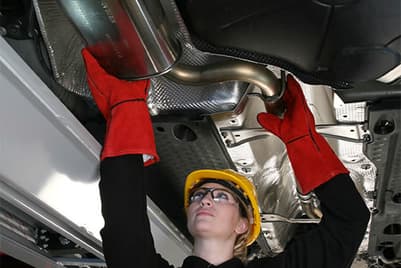What is a catalytic converter?
A catalytic converter is a vitally important component of your car. In this article, we will be explaining everything you need to know about the catalytic converter and its role in reducing harmful emissions.

What is the job of a catalytic converter?
The job of a catalytic converter or CAT, is to extinguish any harmful and dangerous gases before they are removed from the tail pipe and into the atmosphere. The catalytic converter converts these harmful gases into environmentally friendly gases before they leave the exhaust system. If your catalytic converter is faulty, this can lead to a fine and cause black smoke to come from your vehicle. The lifespan of a catalytic converter depends on your driving style and frequency of driving.
How long do catalytic converters last?
A catalytic converter can last up to 10 years, however, this will depend on your driving style and how often you drive your vehicle. 10 years equates to on average around 70,000 to 100,000 miles, so if you drive your car regularly, then your catalytic converter may need changing sooner. It is important to note that a faulty catalytic converter can result in an MOT failure. For more details on this please click on the related article below.
Related: Faulty catalytic converters and MOT's
If you only use your vehicle for short journeys, this will reduce the lifespan of the catalytic converter as the engine will not operate at its maximum temperature level meaning the catalytic converter will wear out more quickly.
Which harmful gases does a catalytic converter protect against?
The three gases that are damaging to the atmosphere are Hydrocarbons, Carbon Monoxide and Nitrogen Oxides. It is the job of the catalytic converter to convert these gases into ‘friendly gases’ to prevent smog and acid rain. The catalytic converter is the most pivotal part of the emissions control system and was first created in 1975. Nowadays, many diesel cars are fitted with a diesel particulate filter- this removes a higher number of particulates and helps in soot reduction.
How catalytic converter work alongside the exhaust system?
The exhaust is made up of a number of different mechanisms, including the exhaust manifold, the catalytic converter, the silencer, the exhaust pipe and the tailpipe. After the exhaust manifold has captured the gases, these are pushed through to the through engine cylinders and out through the atmosphere from the tail pipe. However, before the gases are released, the catalytic converter reduces the number of harmful emissions, as well as passing through a silencer which reduces external noise levels.
If a car has a faulty catalytic converter, this will be obvious as the smoke emitted from the vehicle will be a noticeably different colour. To find out more about different types of exhausts emissions, please click on the related article below and scroll down to the FAQ titled: What do different types of exhaust smoke mean?
Related: What do different types of exhaust smoke mean?
Can I get my catalytic converter checked?
At National Tyres and Autocare, we offer a number of ways that your catalytic converter can be examined. We offer a FREE exhaust check, including checking the catalytic converter. We also offer a FREE vehicle safety check, as well as a number of different servicing options. Your exhaust and the catalytic converter will also be checked during an MOT.
If you have any questions about catalytic converters, then don’t hesitate to get in touch. You can contact us by using our live chat feature on our website, as well as heading over to our social media channels (National Tyres Facebook) where our highly trained staff will be able to help. Alternatively, you can ring your local National Tyres branch and they will be able to assist. If you think you have any issues with your catalytic converter or your exhaust system in general, we would advise that you book in for a free exhaust check at your local National Tyres branch. You can book in for a free exhaust check by clicking on the related article link below.
Related: Book an exhaust check
Did you enjoy this blog post? |7 people found this review helpful



 Sign up for SPECIAL OFFERS
Sign up for SPECIAL OFFERS
